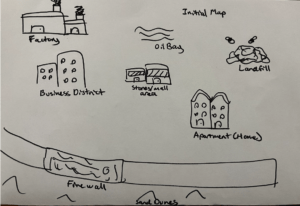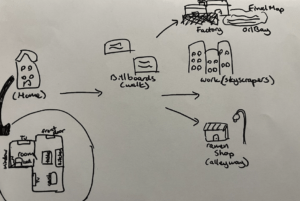OVERVIEW
Premise:
Initially, I was interested in highlighting the harms of society hyper-focusing on advancing technology, at the expense of nature. But, as I created the storyline, I grew more and more fond of the android character and the main character. I eventually decided to focus on fleshing them out through exploring their dynamics, which shifted the game’s core theme to the experience of day-to-day life with depression (by playing through the eyes of the main character), and the negative consequences of giving up parts of yourself for the sake of conformity (seen through main character’s life after giving up artistry, which was his passion). I really wanted players to see the value in continuously trying and holding up for a better tomorrow. This is highlighted in the core mechanism of the game – the day by day structure and small choices that gradually add up to something unexpected, eventually changing the main character’s life drastically (and for the better).
Setting:
The game world is set in a futuristic city (a setting I’ve been interested in exploring). There’s skyscrapers and billboards in the central city (where the main character’s work is), a factory by an oil bay (remnants of the original land development focused plot), a ramen shop, and, of course, the player’s own apartment. Some places are more mundane and grounded in the real world (apartment and ramen shop) while other locations are more futuristic or dystopian cyberpunk themed (central city and factory). This is mainly influenced by my initial story outline for the game (advancing technology at the expense of nature), but it also worked out well for my final plot (one focused on conforming to society and living life with depression).
Role(s):
Main Character – (Player)
A young adult who works as a programmer and used to live with his brother and dad (now lives alone in his apartment). He used to be an artist, mainly on paintings, wall murals or using graffiti cans.
Player’s Journey:
Players start the game being warned of its mundane, repetitive, and slightly boring content. They will then be dropped into a second person point of view. (addressed as ‘you’), but playing as the Main Character, and able to read his thoughts. Every day, players are met with the same choices. What they choose to do day-by-day will gradually accumulate, unfolding the plot or introducing unique interactions bit by bit. Players can choose to do a variety of things each day, to explore this dystopian city and establish a connection with others. There is no time limit, or death flags, etc, but players can choose to quit the game whenever (quit button provided).

Understanding:
For this game, I want players to feel frustrated, or bogged down in the beginning of the game, just like the Main Character. That way, the changes that show up later in the game will make players feel especially surprised or curious. Towards the middle of the plot (factory, leaping over the fence) I want players to feel hopeful and excited (since it is the climax). Through the game, I want to convey what it’s like to live without purpose, a monotonous, depressed life, and the value in trying every day for a change (hence the same choices, format and storyline unlock criterias). I hope the ending made players feel content and happy (hopefully also looking forward to the next one!)
HISTORY VERSIONS + PLAYTESTING
History Versions of Game:
[Prototype 1 – Sticky Notes] (3 playtesters, count as 1)
The first playtests were with the Sticky Notes Prototype, conducted on 10/17/2023. Players were given the sticky notes (each being a frame) and read through them, going through the beginning, day 1, and end of the game. My playtesters were Elliot (23 yr old male), Elizabeth (22 yr old female), and Ting (21 yr old female). All three are avid gamers (self-reported), and provided valuable feedback on the storyline and game mechanisms.
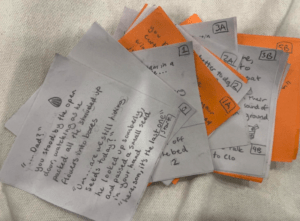
Goals
-Test mechanisms in consideration (give up button, unlocking stories based on stats, same options but changes occur based on # of times clicked)
-Test storyline (is it engaging? Do you feel like you can connect with the main character? Is exploring the world of interest to the player?)
-Test mood and vibe (How does this game make the players feel? Is it calming and slice-of-life or anxiety inducing?)
Observations / Insights / Feedback
Before playtesting, Elliot said he had no clue what my game was, and didn’t feel anything particular. At the end of the playtest, Elliot said he sees potential in the character, exclaiming “He’s just like me! You’re basically describing my life right now.” He suggested keeping the Give Up button, despite not using it much, maybe because it was reassuring to know that he could back out of the game whenever.
Elizabeth loved the game, and added her own sound effects occasionally. She said the little drawings were helpful in helping her imagine the world, especially since it’s more futuristic and cyberpunk related (which she was unfamiliar with). She suggested keeping the locked story mechanism, just because it helps me organize what happens for the player day to day and have more agency on the story progression.
Ting wasn’t able to take a long time to playtest, but brought up a good point about the stats chart, saying that it gave her subtle pressure to choose choices that kept the stats high. Her advice was to either remove it or hide it for the player.
Changes
In response to everyone’s feedback, I took out the stats chart, but kept the give up button and locked story mechanism. Achieving a ‘goal’ was definitely not what I wanted players’ experience to be; it was very important that I keep the game very day-to-day, and up to the player to make choices.
Everyone seemed engaged during gameplay (no looking elsewhere, no stopping or confusion) so I decided to continue with the story, adding more events and scenes to flesh it out. Seeing Elizabeth’s gameplay made me decide to add images and audio to the game (given the time). With these adjustments, I moved the game from existing as sticky notes to an outline (much longer, mapped out beyond Day 1, markers for scene changes, audio effects, and images included).
[Prototype 2-4 – Outline V1, V2, V3] (2 playtesters)
I conducted two more playtests, this time focusing on the storyline. These were conducted on 10/21/2023 and 10/22/2023. Players sat across from me and I acted as the game, reading out the story (based on the outline) then letting them make choices. My playtesters were Vivian (16 yr old female), and Rosemund (24 yr old female). Both are gamers, mostly playing dialogue heavy games like Genshin Impact, or Otome games, which I thought would be similar enough to my game for them to give me valuable insights.
Link to Outlines:
https://docs.google.com/document/d/1aSjE22bN4bDkHHkRMrcNfSbeaEh45MrpHRZ40zy7fB4/edit?usp=sharing
Goals
-Test length of the story (Is it too long to be boring or too short to be engaging? Are the criterias to unlock certain parts too demanding (ie: visit passage 3 times vs 1 time)?)
-Test storyline (Is it engaging? Does it flow like a story should? Do you feel like you can connect with the main character? Did you form a connection with the android character?)
-Test mood and vibe (How does this game make the players feel? Is it a calming slice-of-life or anxiety inducing?)
-Were the themes (living with depression and holding hope for change) clear?
-How does this game experience change for different players (players who tend to choose more passive options versus more active ones)
Observations / Insights / Feedback
Vivian said the story is a bit too long, but loved the android, sunrise, and factory scenes (reference outline).
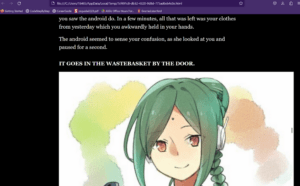
She said the events (visiting the landfill, going to the mall, etc.) could be shorter or cut without affecting the storyline or her game experience. During gameplay, she’d say “Aww” for many of the later passages about the android or “Oh!” for the parts foreshadowing the main character’s brother.

I’d assume she was engaged, since she tended to ask and guess what might happen later on in the story. Frustration was seen (“Ahh” or “Again?”) when she kept getting the same passages for her choices.
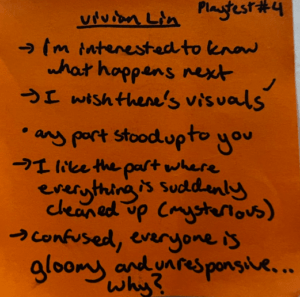
Rosemund was less emotionally tied to the game, but her playtest revealed something I hadn’t considered before. She’s more passive as a person, and that showed in her choices. She went through 5 days or so before beginning to pick more active choices, like going outside (all on her own, without prompting).

She said the game was very sad in the beginning – that she felt sympathy for the main character because she’s been in a slump like that before. This was evident in her comfort to keep clicking the passive choices (choices that didn’t push Main Character out of his comfort zone). She visibly perked up during the brother’s scene (at the factory) and immediately said “That’s the brother, right?”
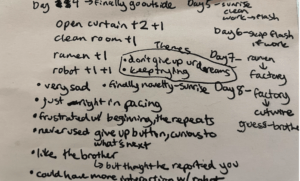
Both playtesters never used the Give Up button, but when asked about it, said I should keep it (for the same reason as Elliot said). Rosemund said she didn’t get to interact with the android enough to feel a connection with her, and was confused as to who sent the notice at the end (she thought the brother sent it).

Changes
In response to their feedback, I cut parts of the story, mainly events here and there, and dialogues (cut the oil bay memory scene, landfill scene). The story was cut from 10+ days to 6+ days (Outline 1 to 2). I playtested with Vivian and Rosemund again, who said the story was still much too long (more frustrating moments than surprise or happiness, while I wanted an equal balance). I ended up cutting some more of the story, from 6+ days to 5+ days, each day being drastically shorter. To achieve that, I removed some characters (the Dad) to make room for giving more scenes to others (the android), based on Rosemund’s feedback. The Dad’s backstory was instead given to the main character to flesh out his past (and to help players connect with the Main Character more). I kept the factory scene and made it the central climax of the storyline, since both playtesters showed visible surprise and excitement during those passages (high engagement).
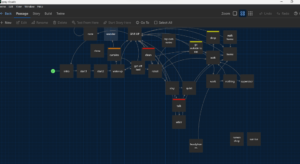
[Prototype 5-7 – Twine V1, V2] (2 playtesters)
I conducted 2 playtests for the Twine versions, this time focusing on translating the story to Twine through using Twine’s tools as efficiently as possible. These playtests were conducted on 10/24/2023 and 10/27/2023. Players were left to play through the game on Twine without any direction (but I was available for any questions or bug reports). My playtesters were Alex (23 yr old male) and Christian (21 yr old male). Alex is a gamer, stating that he plays mostly intense, shooter games. Christian doesn’t play games but is an avid writer.
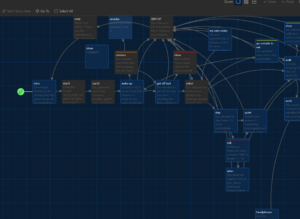
Goals
-Test mechanics (use of if/else statements to unlock passages, coloration of choices and its effect on players’ perception of story length, effects of text style choices)
-Test storyline (Does it feel more lengthy on Twine than when it was read to players? Should I cut more scenes in response to that?)
-Test mood and vibe (Is there sufficient world building?)
Observations / Insights / Feedback
Alex tested Twine V1 (backstory, all of Day 1-2, the sunrise scene) and said he’s not into mundane games that much. When asked what could be done to make the game more engaging, he said that having one big scene (climax) would keep him playing the whole game just for that moment. I planned to have that scene be the factory passages. He also expressed wanting to explore different branches (which I saw him do using the back button). 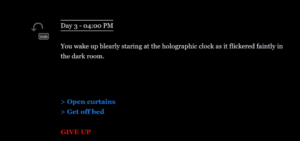
He did note that it’s easy to lose track of time throughout the day, sometimes forgetting it’s still Day 1.
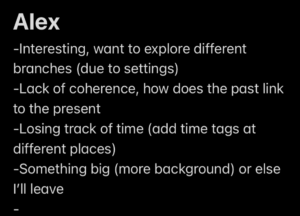
Christian played the game at Twine V2, and liked the game a lot in terms of the premise, main character, and setting. He did tell me to fix the bugs (sunrise came at first visit, was supposed to come much later, ramen shop was never encountered, some stray words here and there that should be removed). He said the images are nice, but might need to be scaled down, as they’re very in-your-face and took away his focus from the story.
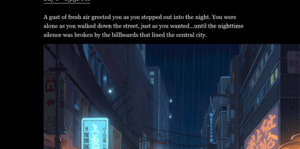
![]()
Both expressed interest in playing the game again (when it’s all done).
Changes
In response to their feedback, I added timestamps for most of the passages, because I did want to immerse players in the day-to-day feeling. I did, however, leave out the timestamps for certain parts where I really wanted players to solely focus on the scene.

I added the factory scene into Twine after Alex’s playtest (Twine V1 -> V2).
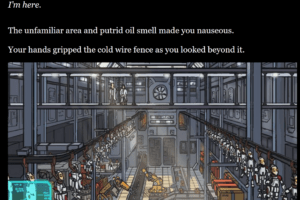
After Christian’s playtest, I also fixed most of the bugs in my game (instead of using the if/else statements based on history/past passages visited, I used global variables instead). It’s a bit messy, but I’m not familiar with coding and couldn’t figure out the bug for the if/else history functions. The variables work well, and the story is now free of those bugs Christian and Alex encountered. I also scaled down the images in response to Christian’s comment, but left some very big ones to keep the surprise and wonder effect (sunrise, street images).
[Prototype – Twine V4 ] (3 playtesters)
The last playtests were after the changes to Twine V1, V2, and V3, conducted on 11/01/2023. My playtesters were Xuanyu (24 yr old female), Graciela (22 yr old, female) and Elyse (22 yr old, female). Elyse and Graciela are in our class, so they have experience as a game designer (especially for IFs). Xuanyu is making a game herself, also IF, but steampunk focused.
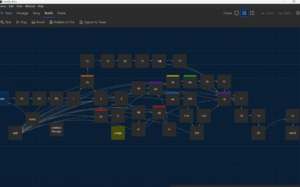
Goals
-Test overall game experience (start to end!)
-Fix any grammatical errors or confusing sentence structure. (Xuanyu happens to be a Hume Center tutor)
-Test mood and vibe (How does this game make the players feel? Is it calming? Engaging? Would they want to play again?)
Observations / Insights / Feedback
Xuanyu loved the game, saying it has a very indie game feel. She said it’s actually more depressing than a very sad game she’d played, called ‘Omori’. She liked that players are given options, but the main character’s choices can override it (like you click ‘clean up my room’ but the character says ‘why bother’). It gives the player agency, but also the character a personality.
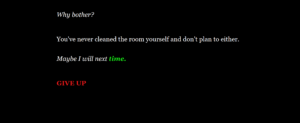
She gave me some suggestions in terms of writing, like what words could be changed (robot to android, since the maid is human-like). She commented that the story is very sweet, very calming, and evokes different sensory responses. She did comment that the first few days feel way too long, bogging her down a bit. But at the end, she asked me to send her the game when it’s finished, suggesting that she wanted to see the end.
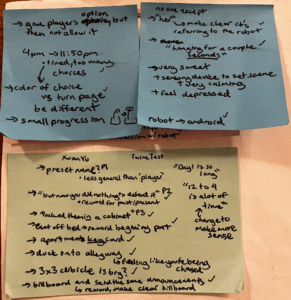
Elyse said it’s a bit hard to know what to do next, and that might end up taking players a long time to get to the main storyline (Graciela said something similar; she had trouble getting to the factory scene). She also suggested using special effects for the texts, like borders for papers or notices, and flashing for the holographic time. She read everything, saying it’s not that long, thought the pictures were a nice touch to make changes stand out, and did get the monotonous vibe from the first few days of the game.
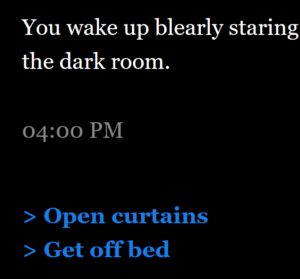
Graciela’s feedback had some commonalities with Xuanyu and Elyse, except I noticed that she wasn’t too engaged (would look around, skip passages, etc). When asked if she felt a connection with any of the characters, she said not really, because for her, there wasn’t enough backstory on them.
Changes
In response to their feedback, I edited the texts, and set two different colors for choices players can make (in blue) versus progressing the story (in green). That way, it is more broken up, and will feel less like the player made a ton of choices each day (and hopefully be less disengaging).
I also added hints like “maybe I should talk to the android next time…” or “maybe the next day this ramen shop won’t be so busy..” so that players can figure out how to get to the main storyline (response to Elyse and Graciela’s point).

I was able to add the flicker effect and borders as well, making longer passages more dynamic.
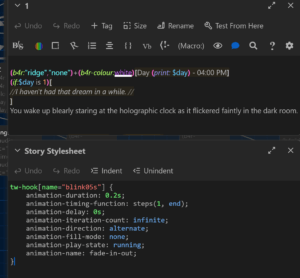
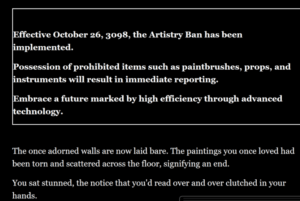
It seemed like all three of my playtesters had trouble getting to the main storyline (Xuanyu even started sighing a lot at one point). After some reflection, I did a major change to the structure of plot unlocking (which I had to think through for a while). I didn’t want to add choices bit by bit, because I wanted players to have agency in what they do every day. I didn’t want to have a help button where I redirect them, because it disrupts the flow of the story and also makes the gameplay more goal-oriented. Most importantly, the game cannot feel very linear. The initial frustration, boredom, and struggle have to be experienced by the players.
That being said, I also want players to enjoy the story by getting to the main storyline in a reasonable amount of time. So, instead of it being chronological where players had to do one setting first to get a special scene in another setting [talk to android->work->ramen shop-> main storyline], the story is now a hybrid of chronological and free unlock [work -> ramen shop] [talk to android, work, could be out of order). I also lowered the requirements for unlocking passages (visit 2 times instead of 3 or 4) and removed some branches after players have fully explored them (work, talk to android). The goal was for players to go about their day however they like, but eventually unlock the main storyline naturally. Their choices matter, in the sense that it influences their own game experience and emotions felt during the game (many passive choices -> more repeats, more frustration). Whether or not they talk to the android would not affect the main storyline, but does affect how connected players felt with the android.
REFLECTION
I enjoyed the game creation process, and now am very attached to perfecting this game (which is a good thing!). I took more time to work on it; and started drawing my own visuals (I originally planned to use images from online sources for time’s sake). I also added audio, to give players a more immersive experience. I wish I knew how to code more, so the functions and statements would be less messy and I could focus more on developing the plot or visuals (instead of debugging over and over again). I’m a design student, so it was fun doing user testing through a different lens (game design). I learned the value of playtesting, and what to look for from my playtesters before, during, and after a playtest. More than anything, I’m a big fan of slice-of-life, mundane shows/games/manga, and was really happy to put out something of the same genre, to accomplish a similar effect on players as the slice-of-life contents have had on me. Slice-of-life works are my escape from reality, when I feel like the main character of this game; bogged down and unhappy with life. I’m happy with how well this game merged my mundane reality with the slice-of-life magic to encourage keeping hope – both for players and myself.
Game Link:
https://joy-ful.itch.io/day-1



